冀教版三年级英语教案
冀教版三年级英语上册教案优秀5篇
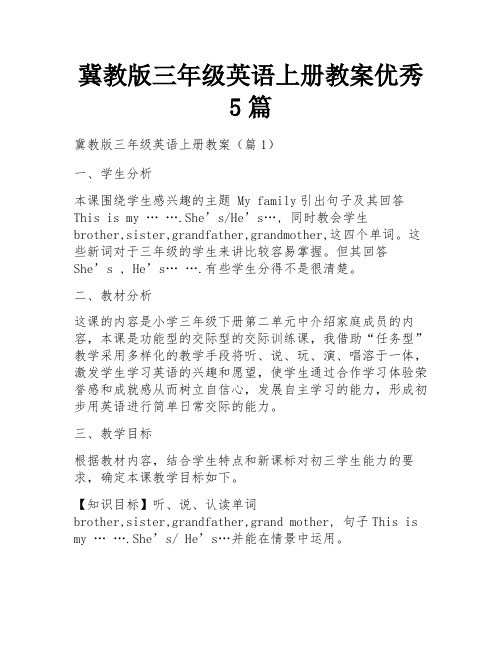
冀教版三年级英语上册教案优秀5篇冀教版三年级英语上册教案(篇1)一、学生分析本课围绕学生感兴趣的主题 My family引出句子及其回答This is my … ….She’s/He’s…, 同时教会学生brother,sister,grandfather,grandmother,这四个单词。
这些新词对于三年级的学生来讲比较容易掌握。
但其回答She’s , He’s… ….有些学生分得不是很清楚。
二、教材分析这课的内容是小学三年级下册第二单元中介绍家庭成员的内容,本课是功能型的交际型的交际训练课,我借助“任务型”教学采用多样化的教学手段将听、说、玩、演、唱溶于一体,激发学生学习英语的兴趣和愿望,使学生通过合作学习体验荣誉感和成就感从而树立自信心,发展自主学习的能力,形成初步用英语进行简单日常交际的能力。
三、教学目标根据教材内容,结合学生特点和新课标对初三学生能力的要求,确定本课教学目标如下。
【知识目标】听、说、认读单词brother,sister,grandfather,grand mother, 句子This is my … ….She’s/ He’s…并能在情景中运用。
【能力目标】能通过询问知道一些人物是谁,能根据主题My family展开对话,并尝试模仿情景自编对话。
【情感目标】通过创设情景,增长课外知识,激发学生热爱自己家庭成员的美好情感。
【学习策略】注重观察、模仿、理解和想象。
四、教学策略为了顺利完成教学目标,更好地突出重点,突破难点,我设计了五个有序的环节:热身、预习、新教、练习、任务,目的是为学生创设情景,在轻松愉快的氛围中学习英语。
教学不是简单的知识传授。
为了不使教学变得枯燥,我采用各种教学方法,如对比明星的形象、家庭照片等,启发和引导学生的思维,培养学生在不同层面大胆用英语交流的能力,让学生真正进入实际情境进行交流。
课题:Unit 2 My family (B部分第一课时)教学流程:一、复习热身:1、游戏:Now,first,Let’s play a game :You can say: “Yes or No”.This is __×. He is a boy/girl.This is __×. She is a girl/boy.(指明七、八学生回答).2、 Meet my family:(拿照片)a、指定学生回答:Who’s th at man ? This is my father .(板书)Who’s that woman ? This is my mother .(板书)也可指明其他二、三名学生回答。
冀教版三年级英语上册教案_三年级英语上册教案(最新4篇)
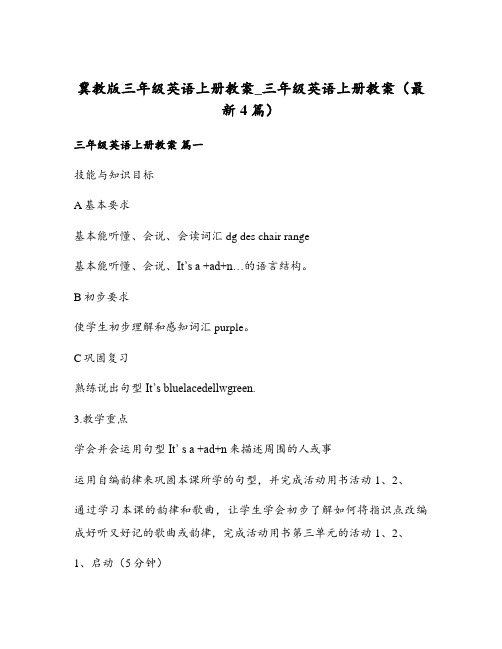
冀教版三年级英语上册教案_三年级英语上册教案(最新4篇)三年级英语上册教案篇一技能与知识目标A基本要求基本能听懂、会说、会读词汇dg des chair range基本能听懂、会说、It’s a +ad+n…的语言结构。
B初步要求使学生初步理解和感知词汇purple。
C巩固复习熟练说出句型It’s bluelacedellwgreen.3.教学重点学会并会运用句型It’ s a +ad+n来描述周围的人或事运用自编韵律来巩固本课所学的句型,并完成活动用书活动1、2、通过学习本课的韵律和歌曲,让学生学会初步了解如何将指识点改编成好听又好记的歌曲或韵律,完成活动用书第三单元的活动1、2、1、启动(5分钟)活动1、复习歌曲第一模块第三单元的歌曲以及以前学的彩虹歌曲活动2、问候语互答(注此时可提前完成第三单元的活动二)首先向学生进行简单的问候问候语,出示动物卡片chaelen panda(Panpan)并介绍新朋友Bb(dg ),向学生进行问候,组织学生两人一组进行彼此的问候,如:A: Gd rning I’ … What’s ur nae?B: Hell,I ‘…活动3、小游戏“luc dg”教师先进行简单的单词卡片复习,表扬做好的学生,开始游戏,教师先给学生示范,背过身向后抛出玩具,谁接住就立刻回答出教师指的颜色(教室里的事物或颜色卡片),如果回答对了,就继续教师的游戏,如果错了,就当站着大家的颜色参照物(以他的衣服颜色为准。
)教师用语:u are reall sething. It’s tie fr gae !Are u read t pla?活动1、让学生展示自己的小作品(画的各种颜色的小卡片),好的挑出来表扬,并让大家说出它的颜色。
(此时,还可趁机收集学生的卡片,找寻是否有与本课有关的颜色动物或物体卡片,如blue dg, green des, red chair之类用学生自己的卡片,会更加鼓舞孩子学习的动力,为以后的活动也打下了良好的基础,若没有或不全,教师下面的活动也可采用自备的卡片。
三年级上册英语教学设计-Lesson 1 Hello 冀教版
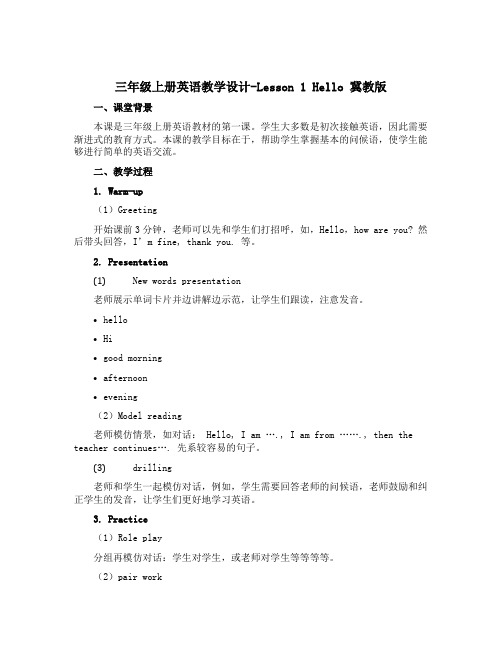
三年级上册英语教学设计-Lesson 1 Hello 冀教版一、课堂背景本课是三年级上册英语教材的第一课。
学生大多数是初次接触英语,因此需要渐进式的教育方式。
本课的教学目标在于,帮助学生掌握基本的问候语,使学生能够进行简单的英语交流。
二、教学过程1. Warm-up(1)Greeting开始课前3分钟,老师可以先和学生们打招呼,如,Hello,how are you? 然后带头回答,I’m fine, thank you. 等。
2. Presentation(1)New words presentation老师展示单词卡片并边讲解边示范,让学生们跟读,注意发音。
•hello•Hi•good morning•afternoon•evening(2)Model reading老师模仿情景,如对话:Hello, I am …., I am from ……., then the teacher continues…. 先系较容易的句子。
(3)drilling老师和学生一起模仿对话,例如,学生需要回答老师的问候语,老师鼓励和纠正学生的发音,让学生们更好地学习英语。
3. Practice(1)Role play分组再模仿对话:学生对学生,或老师对学生等等等等。
(2)pair work老师发放练习卷,学生两人一组做练习。
4. Production学生小组制作一个小片段来展示他们所学到的问候语,例如用英语来问候父母、亲戚或朋友等等。
三、教学重点展示新词汇和语法结构,鼓励学生模仿,强化竞争,并在练习中巩固所学内容。
四、教学总结本课是初学者的入门课程,因此,教学方法应该是以模仿为基础,慢慢地适应学习英语的节奏和总体学习目标。
在完成本堂课后,学生应该得到了一些基本的交际技能,并掌握了基本的问候语,如hello, good morning和good evening等等。
重点是鼓励孩子们热爱英语,让他们在早期就能够开始学习英语,并迅速提高自己的水平。
三年级英语上册全册教案(冀教版三起)
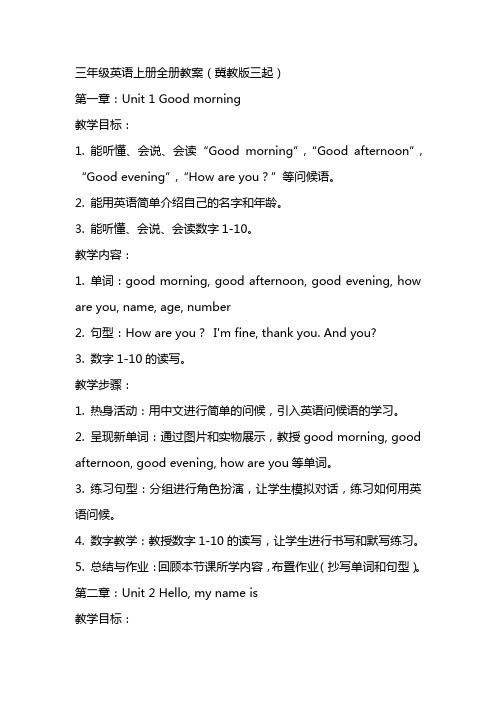
三年级英语上册全册教案(冀教版三起)第一章:Unit 1 Good morning教学目标:1. 能听懂、会说、会读“Good morning”,“Good afternoon”,“Good evening”,“How are you?”等问候语。
2. 能用英语简单介绍自己的名字和年龄。
3. 能听懂、会说、会读数字1-10。
教学内容:1. 单词:good morning, good afternoon, good evening, how are you, name, age, number2. 句型:How are you?I'm fine, thank you. And you?3. 数字1-10的读写。
教学步骤:1. 热身活动:用中文进行简单的问候,引入英语问候语的学习。
2. 呈现新单词:通过图片和实物展示,教授good morning, good afternoon, good evening, how are you等单词。
3. 练习句型:分组进行角色扮演,让学生模拟对话,练习如何用英语问候。
4. 数字教学:教授数字1-10的读写,让学生进行书写和默写练习。
5. 总结与作业:回顾本节课所学内容,布置作业(抄写单词和句型)。
第二章:Unit 2 Hello, my name is教学目标:1. 能听懂、会说、会读“Hello, my name is”,“What's your name?”等问候语。
2. 能用英语介绍自己的名字和年龄。
教学内容:1. 单词:hello, my name is, what's your name, age2. 句型:Hello, my name is What's your name?My name is How old are you?I'm years old.教学步骤:1. 热身活动:用中文进行简单的自我介绍,引入英语自我介绍的学习。
冀教版三年级英语上册教案
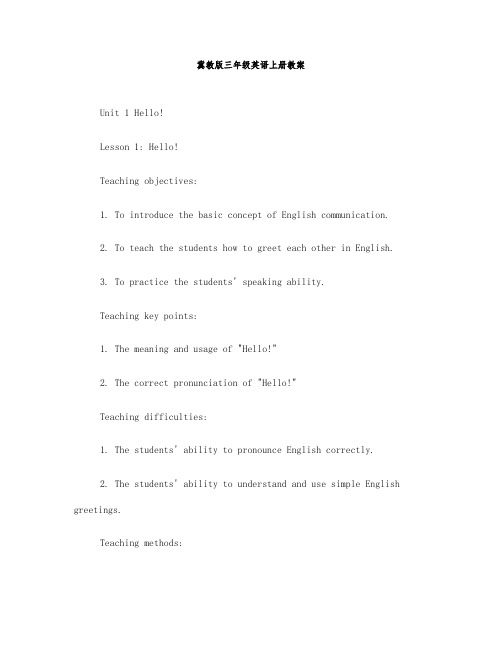
冀教版三年级英语上册教案Unit 1 Hello!Lesson 1: Hello!Teaching objectives:1. To introduce the basic concept of English communication.2. To teach the students how to greet each other in English.3. To practice the students' speaking ability.Teaching key points:1. The meaning and usage of "Hello!"2. The correct pronunciation of "Hello!"Teaching difficulties:1. The students' ability to pronounce English correctly.2. The students' ability to understand and use simple English greetings.Teaching methods:1. Multimedia teaching: Use multimedia to show the correct pronunciation and intonation of "Hello!"2. Role-play: Encourage the students to practice greeting each other in English.3. Game method: Use games to enhance the students' interest in learning English.Teaching procedures:1. Review: Review the previous lesson to ensure that the students have a grasp of basic English communication skills.2. Greeting: Use "Hello!" as the entrance, let the students learn how to greet each other in English.3. Practice: Encourage the students to practice greeting each other in English, focusing on pronunciation and intonation.4. Game: Design a game for the students to play, such as "Who Can Say Hello?" Let the students practice their English greeting ability in a lively atmosphere.5. Summary: Summarize the lesson, focusing on the correct pronunciation and intonation of "Hello!" and the correct usage of English greetings.6. Homework: Assign homework to let the students practice their English greeting ability at home, such as asking their family members to greet each other in English.。
冀教版三年级上册英语教案5篇
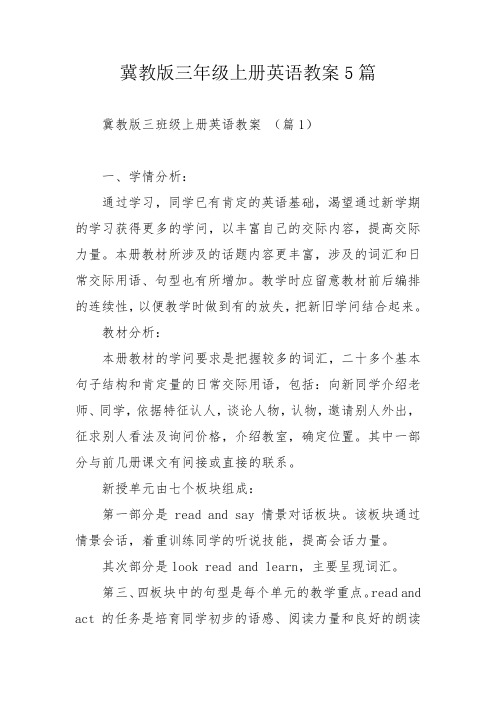
冀教版三年级上册英语教案5篇冀教版三班级上册英语教案(篇1)一、学情分析:通过学习,同学已有肯定的英语基础,渴望通过新学期的学习获得更多的学问,以丰富自己的交际内容,提高交际力量。
本册教材所涉及的话题内容更丰富,涉及的词汇和日常交际用语、句型也有所增加。
教学时应留意教材前后编排的连续性,以便教学时做到有的放失,把新旧学问结合起来。
教材分析:本册教材的学问要求是把握较多的词汇,二十多个基本句子结构和肯定量的日常交际用语,包括:向新同学介绍老师、同学,依据特征认人,谈论人物,认物,邀请别人外出,征求别人看法及询问价格,介绍教室,确定位置。
其中一部分与前几册课文有间接或直接的联系。
新授单元由七个板块组成:第一部分是read and say情景对话板块。
该板块通过情景会话,着重训练同学的听说技能,提高会话力量。
其次部分是look read and learn,主要呈现词汇。
第三、四板块中的句型是每个单元的教学重点。
read and act的任务是培育同学初步的语感、阅读力量和良好的朗读习惯。
listen and repeat是语音训练板块。
fun house是一个活动板块。
二、双基目标1、把握每个单元的词汇和句型。
2、能在实际生活中运用达到学以致用的目的。
三、情意目标1、培育深厚的学习爱好。
2、培育良好的学习习惯。
3、培育同学间的协作精神和爱国主义精神。
四、教学重点1、单词和句型的正确书写和流利朗读。
2、精确流利朗读会话,并敏捷运用。
五、教学难点正确书写单词和句型。
六、主要措施1、以活动为课堂教学的主要形式,设计丰富多彩的教学活动,让同学在乐中学、学中用,从而保证同学英语学习的可持续性进展。
2、通过听、说、读、写、唱、游、演、画、做等形式,进行大量的语言操练和练习。
3、将直观教具和电教手段,多媒体课件相结合,培育同学良好的朗读习惯,打下良好的语音语调基础。
4、设计全面、高效的课外作业,培育同学良好的书写习惯,做到干净、规范、正确地书写。
冀教版三年级上册英语全册教案【全套】

冀教版小学英语三年级上册教案UNIT 1 School and NumbersLesson 1 Hello!【教学内容】Lesson 1【教学目标】掌握最基本的打招呼方式及询问对方的姓名并回答其提问。
【教学重、难点】1. 培养学生学英语的兴趣,敢于用英语和人交流。
2. 帮助学生掌握单词及句子正确发音。
【教学准备】教师:准备中国地图和加拿大地图的图片学生:开始新的学期和英语学习的愉悦的心情【教学课时】1课时【教学过程】【教学目标】A. 知识目标:a. 认识三个人物:Li Ming 、Jenny Smith 、Dannyb. 掌握新句型:Hello/Hi. My name is ________. What ’s your name ?B. 能力目标:让学生学会怎样有礼貌地和别人打招呼,怎样来介绍自己,并能应用自己所学到的知识。
C. 情感目标:通过本课的学习,让学生知道怎样有礼貌地打招呼,做个有礼貌的好孩子。
【教学重、难点】1. 学习新单词,做到三会(会读、会听、会说):hello / hi 你好2. 掌握新句子,做到两会(会听、会说):What’s your name? 你叫什么名字?My name is ______. 我的名字是______。
I live in ______. 我住在______。
【教学过程】Part 1:导入Greetinga.用Hello /Hi 向学生打招呼问好b.再用英语向同学们做简单的自我介绍T: Hello. My name is ______. 指着自己,说出名字。
重复几次让学生明白是什么意思。
(设计意图:引起学生对英语的好奇心,激发学生的兴趣)Part 2:新授1. 介绍书中的人物。
由于学生是刚接触到这几个小朋友,而且他们要和我们一起学习、一起成长,所以教师很有必要让学生认识这几个人。
利用图片分别介绍Danny、Jenny Smith 和Li Ming。
同时告诉学生Danny和Jenny 住在Canada (加拿大),Li Ming 住在China (中国)。
三年级英语上册全册教案(冀教版三起)
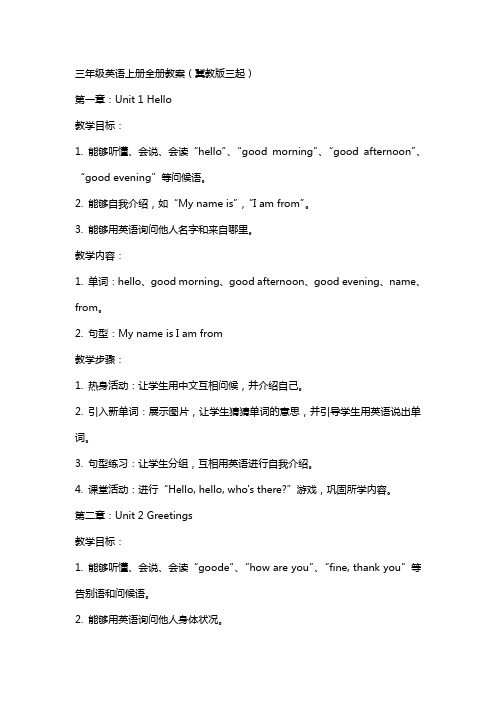
三年级英语上册全册教案(冀教版三起)第一章:Unit 1 Hello教学目标:1. 能够听懂、会说、会读“hello”、“good morning”、“good afternoon”、“good evening”等问候语。
2. 能够自我介绍,如“My name is”,“I am from”。
3. 能够用英语询问他人名字和来自哪里。
教学内容:1. 单词:hello、good morning、good afternoon、good evening、name、from。
2. 句型:My name is I am from教学步骤:1. 热身活动:让学生用中文互相问候,并介绍自己。
2. 引入新单词:展示图片,让学生猜猜单词的意思,并引导学生用英语说出单词。
3. 句型练习:让学生分组,互相用英语进行自我介绍。
4. 课堂活动:进行“Hello, hello, who's there?”游戏,巩固所学内容。
第二章:Unit 2 Greetings教学目标:1. 能够听懂、会说、会读“goode”、“how are you”、“fine, thank you”等告别语和问候语。
2. 能够用英语询问他人身体状况。
教学内容:1. 单词:goode、how are you、fine、thank you、ill、better。
2. 句型:How are you? I am fine, thank you. I am a little ill, but I am getting better.教学步骤:1. 复习上一单元的单词和句型。
2. 引入新单词:展示图片,让学生猜猜单词的意思,并引导学生用英语说出单词。
3. 句型练习:让学生分组,互相用英语询问身体状况。
4. 课堂活动:进行“How are you?”游戏,巩固所学内容。
第三章:Unit 3 Colors教学目标:1. 能够听懂、会说、会读“red”、“yellow”、“blue”、“green”等颜色单词。
- 1、下载文档前请自行甄别文档内容的完整性,平台不提供额外的编辑、内容补充、找答案等附加服务。
- 2、"仅部分预览"的文档,不可在线预览部分如存在完整性等问题,可反馈申请退款(可完整预览的文档不适用该条件!)。
- 3、如文档侵犯您的权益,请联系客服反馈,我们会尽快为您处理(人工客服工作时间:9:00-18:30)。
Lesson16 Breakfast,Lunch and Dinner【课题】:Lesson16 Breakfast,Lunch and Dinner;This lesson has oneclass.【课型】:New class.【课标定位】:1.Can speak new words and phrases.2.Can understand the simple story with the help of pictures.【教学目标】:1.Be able to read and spell the following words: breakfast,lunchdinner, morning, afternoon, evening, night.2.To apply the learned words and sentences in daily life. 【教学重点】:Can listen, say, remember the words: good,breakfast,lunch,dinner, morning, afternoon, evening, night.【教学难点】:The flexible use of actual life.【自学指南】:Try to understand the content of dialogue according to the words given.【自学测评】:Find out the difficult words and sentences.【情景引入】:We all know that there are three meals a day, we will learn words on three meals in this class.【核心活动】:Step1:Warm-up! 1. Greeting: the teacher and students greet for each other to close thedistance between the teacher and students.2. Review morning, afternoon and evening. For example, ask the studentsto say in Chinese what activities they do in the morning/afternoon/evening.Write on the blackboard.Step2: New ConceptsPart1.Breakfast,lunch or supper?Please look at the book and guess what the pictures are about.(Teacher says the sentences and do the action to help students understand the Chinese meaning of morning, afternoon, evening. If necessary, we can explain in Chinese.)1. Present: Write breakfast, lunch and supper on the blackboard andtranslate each word. Practice saying the words with the class a few times.2. Student book: Discuss the pictures in book. For example, ask thestudents to find the words breakfast/lunch/supper i n the sentences a nd ask the times of eating breakfast/lunch/supper.Part2.Practice1. Ask questions to check their comprehension. Use English as much aspossible and use gestures to make your meaning clear. For example: What does Li Ming have in the morning/afternoon/evening?What does Li Ming do after breakfast/lunch/supper?2. Work in pairs:Talk about what they do in the morning, afternoon and evening.Part3.Sing a song:I’s time for lunch【课堂小结】:Class Closingand Ask the students “What have you learnt in this class?” assist them in composing a summary【当堂测评或作业】:Finish the activities in the Activity Book【测评或作业反馈】:【板书设计】:Lesson16 Breakfast,Lunch and Dinnermorning Breakfastafternoon lunchevening dinner/supperLesson17 What’s for breakfast?【课题】:Lesson17 What’s for breakfast?T his lesson has one class.【课型】:New class.【课标定位】:1.learn new words according to the pictures.2.Do the actions accurately according to the instruction.【教学目标】:1.Can listen, speak, read and write the new words: milk, egg, bread.2. Ask and answer: What’s for ____ ?I like ____ for breakfast.【教学重点】:Can read and spell the words: milk, egg, bread.【教学难点】:Students can understand the pronunciation and rules of letters h, w, r, u in the words.【自学指南】:Try to understand the content of dialogue according to the words given.【自学测评】:Try to do the actions according to the instructions.【情景引入】:We have learned some words on food, today we will still learn new words about food.【核心活动】:Step1: Class Opening and Review1.Greeting:Teacher: Hello, boys and girls! Did you eat your breakfast?Students: answers2. ReviewI like ____. /I don’t like ____.Step2: New ConceptsPart1. What’s this ??In the morning, I eat breakfast. What’s for breakfast?”)(Look, ask and answer “What’s thisShow the pictures and introduce the words: milk, eggs, bread.Read these words a few time after teacher.Part2. I like ____ . I like ____ for breakfast.Ask and answer in pairs.What’s for breakfast? I like ___ for breakfast.Part3.Make the dialogues using these sentences:I like ___ for breakfast. Would you like some ____ ?Yes, please. /No, thanks.Part4. practice: Letters and soundersH hungry handW worker windowR ruler riverU student computerStep3. Class Closing【课堂小结】:We have three new words about foods, I hope you remember them【当堂测评或作业】: 1. Students try to say the names of these three foods.2. Finish the activities in the Activity Book【测评或作业反馈】:【板书设计】:Lesson 17 What’s for breakfast?Words: eggs bread milk hungry handworker window ruler rive computerSentences: What’s for breakfast?I like ____ .I like ____ for breakfast.Lesson18 The Magic Stone【课题】:Lesson18 The Magic Stone ; This lesson has one class.【课型】:New class.【课标定位】:Can read and understand the simple story with the help ofpictures.【教学目标】:1.Reviewing the words on food in this unit based on the study ofthe story.2. Can understand the content of story and tell the story withsimple sentences.3. Sentences: May I use it? We have .I have .【教学重点】:1.words: dinner, hungry, soup, chicken, fish, vegetables,noodles.2. Sentences: May I use it? We have .I have .【教学难点】:Can understand the content of story and tell the story withsimple sentences.【自学指南】:1. Find out the words on food learned in this unit.2. Try to understand the story.【自学测评】:Tell the story in Chinese. Yes or No ?【情景引入】:Do you like listening to stories? Today, I bring an interestingstory to you!【核心活动】:Step1: Class Opening1. Lead-in: Greeting.T: Hello boys and girls.Ss: Hello Miss Cui.T: Are you ready for English class?Ss: Yes.T: Ok, let’s go.2. ReviewT: Boys and girls, I have some food, do you want to know?Let’s look at these cards. (Show the cards附1)T: What’s this?Ss: Chicken.T: Good, it’s chicken.T: What are they?Ss: Vegetables.T: Good, vegetables, they are vegetables.………….Step2: New Concepts1. (Lead-in) T: Boys and girls, let’s play a game, guess what’sSs: Chicken, noodles, fish, vegetables, milk…T: What’s missing?Ss: Soup.T: Today I want to make some soup, but I have no Vegetables, nochicken, no fish, I have nothing. I’m sad. But a boy made soup with a stone.what’s this? Ok, stone. Let’s read. Stone, stone.T: This stone is a magic stone. What is the meaning of magic?Look at the blackboard. Magic, 神奇的,有魔力的。
